Blog Archives
September 12, 2003
"Hinduism demands deep devotion through bhakti yoga in the kriya pada, softening the intellect and unfolding love. In kriya, the second stage of religiousness, our sadhana, which was mostly external in charya, is now also internal. Kriya, literally "action or rite," is a stirring of the soul in awareness of the Divine, overcoming the obstinacy of the instinctive-intellectual mind. We now look upon the Deity image not just as carved stone, but as the living presence of the God. We perform ritual and puja not because we have to but because we want to. We are drawn to the temple to satisfy our longing. We sing joyfully. We absorb and intuit the wisdom of the Vedas and Agamas. We perform pilgrimage and fulfill the sacraments. We practice diligently the ten classical observances called niyamas. Our relationship with God in kriya is as a son to his parents and thus this stage is called the satputra marga. The Tirumantiram instructs, "Puja, reading the scriptures, singing hymns, performing japa and unsullied austerity, truthfulness, restraint of envy, and offering of food--these and other self-purifying acts constitute the flawless satputra marga." Aum Namah Sivaya. --Gurudeva
Our Beloved and Revered Satguru Sivaya Subramuniyaswami
Attained Maha Samadhi on November 12th, 2001
Click to read for Details.
We are pleased to announce the web release of Satguru Sivaya Subramuniyaswami's monumental work on Hindu culture and lifestyle:
Living with Siva.
Click here for the entire text and artwork, now on-line!
On the second day of our retreat, September 10th, Bodhinatha and his second team arrived back from their action packed mission.
Bodhinatha's Sun One Video. Most Recent update: August 21, 2003. Bodhinatha speaks on Brahmachariya, purity, yama #4, describing the harnessing of the instinctive and sexual nature. He also give a pre-mission overview of his coming journeys to Mauritius, Malaysia and Singapore. 25 minutes, 23 seconds. FYI for our audio fans: the audio links are now running at the end of this page. See below.
 |
|
|
|
Live Web Cam Pix! |
 |
||||
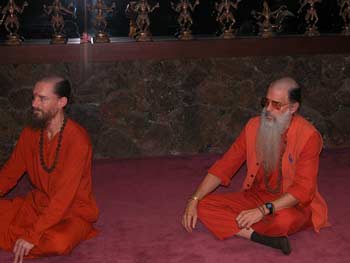
Sannyasins Saravananathaswami (left) and Natarajanathaswami (right) went to Malaysia to cover the last week of events there and in Singapore.
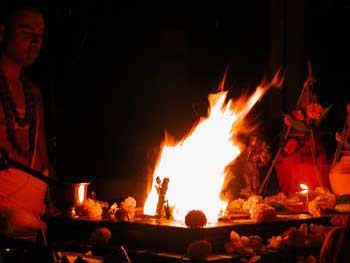
Today was Sun 1 homa and it was good to have everyone back together again... now we continue with the saga of what may have been the most event and interview filled journey of all time! Going back in time now to Malaysia, September 5th....
Sadhaka Jivanandanatha reports: "Today the morning started out with a meeting with some of our members, mainly older youth, who want to teach Hinduism to youth. It was an inspiring meeting. Bodhinatha gave an excellent talk about being practical. Bodhinatha said that in order for young people to deeply accept and stay with Hinduism, they need to experience the practical side of Hinduism. For example a student needs to know that if he worships Ganesha, he will do better on his tests--and actually experience this. Classes should start within a few months. They are starting "practically" by teaching a "test" batch of youth to train the teachers to teach. It was a well organized meeting. One of the leaders of this group is Arvind Raj who visited Kauai for 6 months and was inspired by Gurudeva to do this.
About 10 people are going to be actively involved in the teaching program. A great deal of time has already gone into the preparation and much more time will be invested by the teachers.
Here Arvind Raj explains the program.
After a hour long question and answer session we posed for a group photo.
After stepping outside, Bodhinatha says goodbye. The driver is a friend of the members and graciously donated his car and time.
The previous night at Silvarajoo Muniandy's home we visited with his family: Amutha, Nantha Kumaran, Shivakumaran and Suhashini.
We also met with Brahmacharinis Gowri Nadason and Chudikadevi Saravan.
~~~~~~
OK that's it from Sadhaka Jivanandanatha and Muruganathaswami who at this time headed back for Kauai.... while Saravananathaswami picks up the story line...
He writes: "Natarajnathaswami and I finally arrived after a very loooong journey (over 48 hour transit) ... These are photos from September 6, Saturday, in Malaysia. We had many interviews with families at the hotel, then a wonderful event at the CB Mariamman Temple in Klang where Kailasam Sinnathamby holds classes for a couple hundred bright children. But first, a morning walk around the Pan Pacific Glen Marie Hotel in Shah Alam
Nagalingam family left to right:Pathmarajah, Meena, and Dhanika and mother Nageswari.
Sri Datuk A. Vaithilingam, head of Malaysia Hindu Sangam
Saiva Siddhanta Church sishya: Sivanesan family, Kulamata Thamaraiveni and Kulapati Ananda
Saiva Siddhanta Church sishya: Sivaceyon family left to right: Kulapati Bala, Patudeva, Kulamata Kunawathy, Devaladevi and Nutanaya.
Himalayan Academy Students from the southern state of Johore Bahru....
From Johore: student Ravichandran Ceyon
From Johore: students Mogan and Poongkodi Ramasamy family
From Johore: students Madhu and Omana Raman Narayanan
Another new student from Johore
All Johore students in group photo
Chitraveloo and Mohana Sundari Gunasegaran family receiving a pair of blessed wooden tiruvadi (Guru sandals).
They will keep these in their shrine room.
Saiva Siddhanta Church member-shisya: Sivaram Eswaran with mother and aunt
Just married a few hours earlier: long time sishya since he was a young teenager, Saravana Kumar Kuppusamy with his new wife (apologies for not recalling her name here).
Same couple as above Saravana's father and mother, Kulapati Appasamy and Kulamata Rajaletchmy Kuppusamy
Kandasamy family left to right: Kulapati Murugesu, Kulamata Valiammah, Mohanavilashiny
Family whose two daughters on the left wish to follow the Master Course Correspondence study.
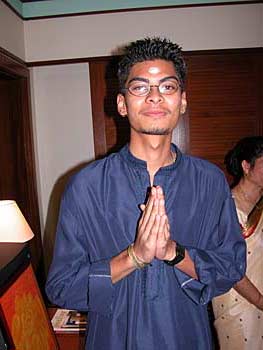
Sishya Gurudasanatha
Gurudasanatha with the rest of his family and a relative. Sister Puvaneswary third from left. Santhramogan second from right. Ganesammal on right.
Sivalingam family left to right: Kulamata Roobavathy, Kulapati Guhan, Rohini and Ratnavathy
Selvavathy Chelliah, Selvanayagi Thuraisingam, Aravindraj Chandrasekaran
Kulapati Thanabalan and Kulamata Ahiladevi Ganesan
The remaining photos below were taken at the evening event at CB Mariamman Temple in Klang where Bodhinatha gave a wonderful talk on ways to "see God". During this event, the youth performed a beautiful song composed for Bodhinatha.
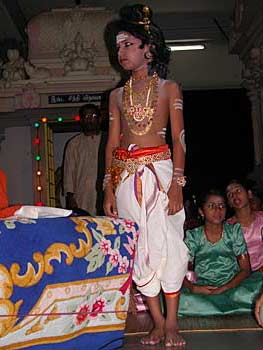
Young boy dressed up as Lord Siva. Stood next to Bodhinatha the whole time.
Bodhinatha give his talk....
Students of the weekly classes listen intently (we hope!)
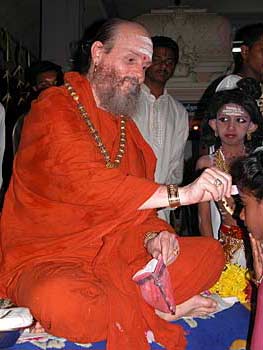
Many, many children and adults came forward for vibhuti prasadam
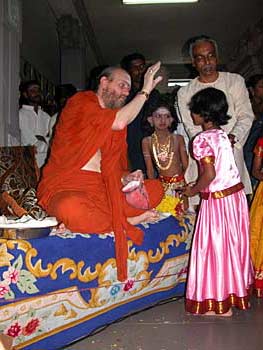
Aum Namasivaya!
Today's Inspired Talk |
|
|
Title: Overview of Upcoming Ganesha Chaturthi Trip Category: Travels, Pilgrimage and Missions Abroad Duration: 15 minutes, 30 seconds Date Given: August 21, 2003 Date Posted:September_12_2003 Given by: Bodhinatha |
|
For more information about listening to Gurudeva's talks online and to hear them in other formats, click here. And click here for an Index to All Past CyberTalks. Study Gurudeva's teachings
every day. Visit the Master Course site!
Bodhinatha will be happy to hold "Prasnottara Satsang" -- "Questions and Answers" over the telephone with any Hindu religious societies, Hindu youth groups, Radio talk show hosts etc. All you need is a phone with a speaker and an enthusiastic audience. Arrangements may be made in advance by sending email to Sannyasin Saravananathaswami If you are experiencing any problems listening to the audio, please to go our Audio FAQ page and follow the directions there.
| FULL INDEX OF 650+ CYBERTALKS
 |
|
Study Gurudeva's teachings.
|
transcription begins
Date: July_22_2003
Title: The Niyama of Ishvarapujana, Worship
Category: Yamas and Niyamas
Duration: 9 min., 42 seconds
Date Given: June 30, 2003
Given by: Bodhinatha
We are working on a series of talks on 'Good Conduct', specifically lessons on the 'Ten Yamas' and the 'Ten Niyamas', the restraints and observances of Hinduism. The lessons are going abroad. The material is being used at the Hindu Center in Singapore, the material is used in classes there. As well as, a number of members in Malaysia are using the material for their classes there.
Today's lesson on 'Good Conduct' is on the fifth Niyama of Isvarapujana, which is to cultivate devotion through daily worship and meditation. Set aside one room of your home as God's shrine. Offer fruit, flowers or food daily. Learn a simple puja and the chants. Meditate after each puja. Visit your shrine before and after leaving the house. Worship in heartfelt devotion, clearing the inner channels to God, Gods and Guru, so their grace flows toward you and loved ones.
Let's look at some examples, illustrating the practice of this Niyama.
First example: Hindus in Bali have an interesting custom. On first seeing one another in the morning, instead of saying, "Good morning!", they ask a question, "Have you worshipped?", which of course is reminding everyone of the importance of the morning worship at the home shrine.
Second example: A Hindu family moved from a two to a three bedroom apartment. The main reason for the move was to be able to set aside an entire room for their home shrine, rather than just having the shrine in a corner of the living room.
Third example: A young man learned a very simple puja from a Hindu elder, who lived nearby. He now peforms the puja every morning before breakfast and finds it puts him in a more religious mood for facing the day.
Fourth example: A Hindu family involves all members of the family in the morning worship. The children gather flowers from the home's garden. Mom cooks a special rice dish to be offered, which is eaten by all during breakfast. Dad conducts the puja, after which they all sit together for a few minutes of silent meditation.
All of the Niyamas focus on expressing the refined soul qualities within each of us. In the case of Isvarapujana, worship of the Lord, the divine quality we are expressing is becoming closer to God, Gods and Guru through performing ceremonial worship at our home shrine.
Gurudeva defined worship in a very insightful way as communicating on a very high level. A truly sophisticated form of "channeling," as New Age people might say. A clairvoyant or clairaudient experience, as mystics would describe it. Or, heart-felt love interchanged between Deity and devotee, as the ordinary Hindu would describe it.
Here �s a story to further illustrate Isvarapujana. A Hindu family has always had a shrine room. However, over the years the husband has systematically learned more about conducting puja. At first he just did a simple mantra to Lord Ganesha while waving incense. Then he learned a few more chants and added passing the arati flame at the end of the puja. Finally he learned the entire 'Ganesha Atmartha Puja', which he now does every morning before breakfast. He finds performing the full puja quite satisfying and that it uplifts all members of the family as well.
The Tirukural in its chapter 1, 'Praising God', mentions worship of God in verse 2.
"What has learning profited a man, if it has not led him to worship the Good Feet of Him, who is pure knowledge itself?"
The chapter states that, "Those who worship, praise and draw near God's Holy Feet, live free of suffering, dispel the mind's distress and enjoy a long and joyous life."
Isvarapujana refers to worship in the home rather than at the temple. It also refers to worship we conduct for ourselves rather than worship done by a priest for us. This worship is done at the home shrine and includes actions as simple as offering a flower to as advanced as performing a full puja. The type of puja done by a lay person is called an 'atmartha puja', personal worship rite, whereas the puja done by the priest in a temple is called a 'parartha puja', public liturgy and worship.
Gurudeva states that many people are afraid to do an 'atmartha puja' because they feel they don't have enough training or don't understand the mystical principles behind it well enough. Most Hindus depend on the priests to perform the pujas and sacraments for them, or to train them to perform home puja and give them permission to do so through initiation, called 'diksha'. However, Gurudeva points out simple pujas may be performed by anyone wishing to invoke grace from God, Gods, and devas.
In fact, in Gurudeva's book, 'Loving Ganesha', he gives a simple Ganesha puja that can be performed by everyone.
After performing the atmartha puja, it is customary to sit for a few minutes in meditation, internal worship, taking in to the soul level the refined feelings, the prana, that the puja has created and which still remains in the room. In this way, we receive maximum benefits from the puja.
Gurudeva does give one restriction on performing this puja, which is that , when anger is experienced, refrain from doing puja for thirty-one days. This is, of course, for a serious outbreak of anger. Simple waving of incense before the icons is permissible, but not the passing of flames, ringing of bells or the chanting of any mantra, other than the simple recitation of 'Aum'. The reason for this restriction is that an angry person would invoke in the Second World, asuras that upset us rather than the devas that bless us.
Let's turn our attention to the home shrine. A cultured Hindu home centers around the home shrine, a special room set aside and maintained to create a temple-like atmosphere in which we conduct puja, read scripture, perform sadhana, meditate, sing bhajans and do japa.
All Hindus have guardian devas who live on the astral plane and guide, guard and protect their lives. The shrine room is a room for these permanent unseen guests, a room that the whole family can enter and sit in and commune inwardly with these refined beings, who are dedicated to protecting the family, generation after generation.
"A token shrine in a bedroom or a closet or a niche in a kitchen is not enough to attract these Divinities," says Gurudeva. One would not host an honored guest in one's closet or have him or her sleep in the kitchen and expect the guest to feel welcome, appreciated and loved.
A home shrine's religious vibration can be strengthened by going to the temple regularly. Specifically, some of the religious atmosphere of the temple can be brought home with you, if you simply light an oil lamp in the shrine room when you return home from the temple. This simple act brings devas who were at the temple right into the home shrine, where from the Second World, they can bless all family members and strengthen the religious forcefield of the home.
Important times for going to the shrine room for blessings are before leaving the home and upon returning to the home. Receiving blessings before leaving uplifts us and puts us in a more religious mood and the blessings received upon returning, purify the aura of any worldliness we acquired while away from the home.
Gurudeva takes the idea of having a separate shrine room in which God and the devas can dwell, one step further. He states that the attitude of a cultured and devout Hindu is that not just one room but his entire home is dedicated to God and that the ideal of Isvarapujana is to always be living with God in God's house, which is also your house. God is our constant companion because He resides in our home.
In conclusion, cultivate devotion through daily worship and meditation. Set aside one room of your home as God's shrine. Offer fruit, flowers or food daily. Learn a simple puja and the chants. Meditate after each puja. Visit your shrine before and after leaving the house. Worship in heartfelt devotion, clearing the inner channels to God, Gods and Guru, so Their grace flows toward you and loved ones.
Aum Namah Sivaya!
transcription ends
|
MORE UPLIFTING THINGS |
2004 Indian Odyssey
Join Satguru Bodhinatha Veylanswami on an 18 day Innersearch to South India, from Jan 19 to Feb 5, as we pilgrimage to ancient monasteries, magnificent 1,000 plus year old sacred temples and meet with India's holy men in a life-transforming adventure. Click on the above link for more details. |
|

|
Check our children and youth section for new items for the young and young at heart! | |
|
1. SIGN OUR GUESTBOOK and receive a FREE GIFT |
||
| 2. Newest Book: LIVING WITH SIVA | ||
|
3. Visiting KAUAI'S HINDU MONASTERY |
||
|
4. Contribute to THANK YOU, GURUDEVA FUND |
||